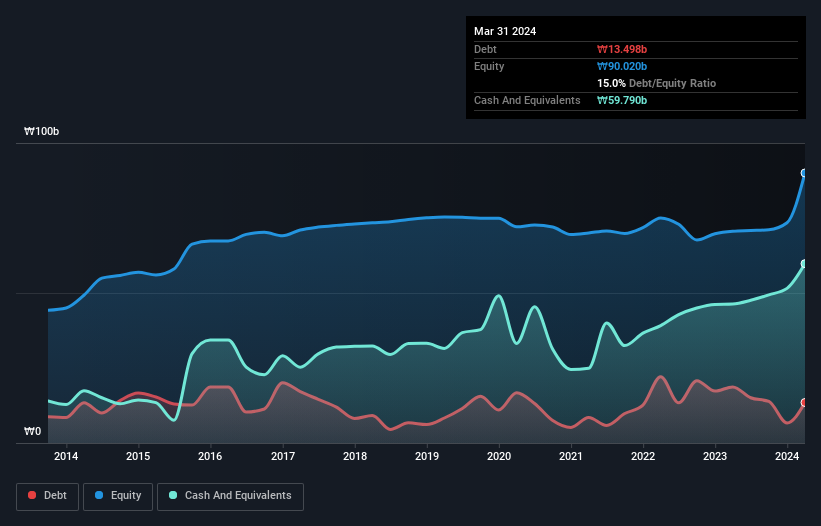- South Korea
- /
- Retail Distributors
- /
- KOSDAQ:A039980
We Think Polaris AI (KOSDAQ:039980) Can Manage Its Debt With Ease
Legendary fund manager Li Lu (who Charlie Munger backed) once said, 'The biggest investment risk is not the volatility of prices, but whether you will suffer a permanent loss of capital.' When we think about how risky a company is, we always like to look at its use of debt, since debt overload can lead to ruin. As with many other companies Polaris AI Corp. (KOSDAQ:039980) makes use of debt. But the real question is whether this debt is making the company risky.
When Is Debt A Problem?
Debt is a tool to help businesses grow, but if a business is incapable of paying off its lenders, then it exists at their mercy. Part and parcel of capitalism is the process of 'creative destruction' where failed businesses are mercilessly liquidated by their bankers. While that is not too common, we often do see indebted companies permanently diluting shareholders because lenders force them to raise capital at a distressed price. Having said that, the most common situation is where a company manages its debt reasonably well - and to its own advantage. When we examine debt levels, we first consider both cash and debt levels, together.
View our latest analysis for Polaris AI
What Is Polaris AI's Net Debt?
As you can see below, Polaris AI had ₩13.5b of debt at March 2024, down from ₩18.7b a year prior. But on the other hand it also has ₩59.8b in cash, leading to a ₩46.3b net cash position.

A Look At Polaris AI's Liabilities
According to the last reported balance sheet, Polaris AI had liabilities of ₩16.9b due within 12 months, and liabilities of ₩2.96b due beyond 12 months. Offsetting this, it had ₩59.8b in cash and ₩4.41b in receivables that were due within 12 months. So it can boast ₩44.3b more liquid assets than total liabilities.
This excess liquidity suggests that Polaris AI is taking a careful approach to debt. Due to its strong net asset position, it is not likely to face issues with its lenders. Succinctly put, Polaris AI boasts net cash, so it's fair to say it does not have a heavy debt load!
It was also good to see that despite losing money on the EBIT line last year, Polaris AI turned things around in the last 12 months, delivering and EBIT of ₩474m. When analysing debt levels, the balance sheet is the obvious place to start. But you can't view debt in total isolation; since Polaris AI will need earnings to service that debt. So when considering debt, it's definitely worth looking at the earnings trend. Click here for an interactive snapshot.
Finally, a business needs free cash flow to pay off debt; accounting profits just don't cut it. Polaris AI may have net cash on the balance sheet, but it is still interesting to look at how well the business converts its earnings before interest and tax (EBIT) to free cash flow, because that will influence both its need for, and its capacity to manage debt. Happily for any shareholders, Polaris AI actually produced more free cash flow than EBIT over the last year. That sort of strong cash conversion gets us as excited as the crowd when the beat drops at a Daft Punk concert.
Summing Up
While it is always sensible to investigate a company's debt, in this case Polaris AI has ₩46.3b in net cash and a decent-looking balance sheet. The cherry on top was that in converted 2,756% of that EBIT to free cash flow, bringing in ₩13b. So we don't think Polaris AI's use of debt is risky. The balance sheet is clearly the area to focus on when you are analysing debt. However, not all investment risk resides within the balance sheet - far from it. For example - Polaris AI has 2 warning signs we think you should be aware of.
If, after all that, you're more interested in a fast growing company with a rock-solid balance sheet, then check out our list of net cash growth stocks without delay.
New: Manage All Your Stock Portfolios in One Place
We've created the ultimate portfolio companion for stock investors, and it's free.
• Connect an unlimited number of Portfolios and see your total in one currency
• Be alerted to new Warning Signs or Risks via email or mobile
• Track the Fair Value of your stocks
Have feedback on this article? Concerned about the content? Get in touch with us directly. Alternatively, email editorial-team (at) simplywallst.com.
This article by Simply Wall St is general in nature. We provide commentary based on historical data and analyst forecasts only using an unbiased methodology and our articles are not intended to be financial advice. It does not constitute a recommendation to buy or sell any stock, and does not take account of your objectives, or your financial situation. We aim to bring you long-term focused analysis driven by fundamental data. Note that our analysis may not factor in the latest price-sensitive company announcements or qualitative material. Simply Wall St has no position in any stocks mentioned.
Have feedback on this article? Concerned about the content? Get in touch with us directly. Alternatively, email editorial-team@simplywallst.com
About KOSDAQ:A039980
Polaris AI
Operates in the fashion and information technology (IT) businesses in South Korea and internationally.
Excellent balance sheet with very low risk.
Market Insights
Community Narratives



